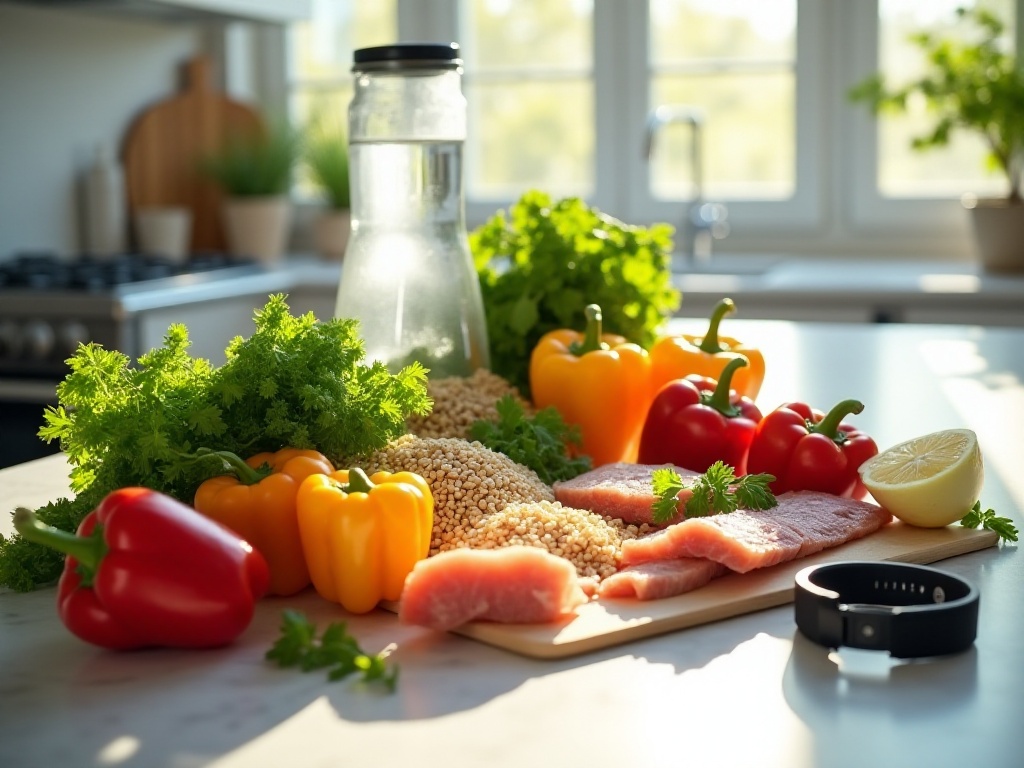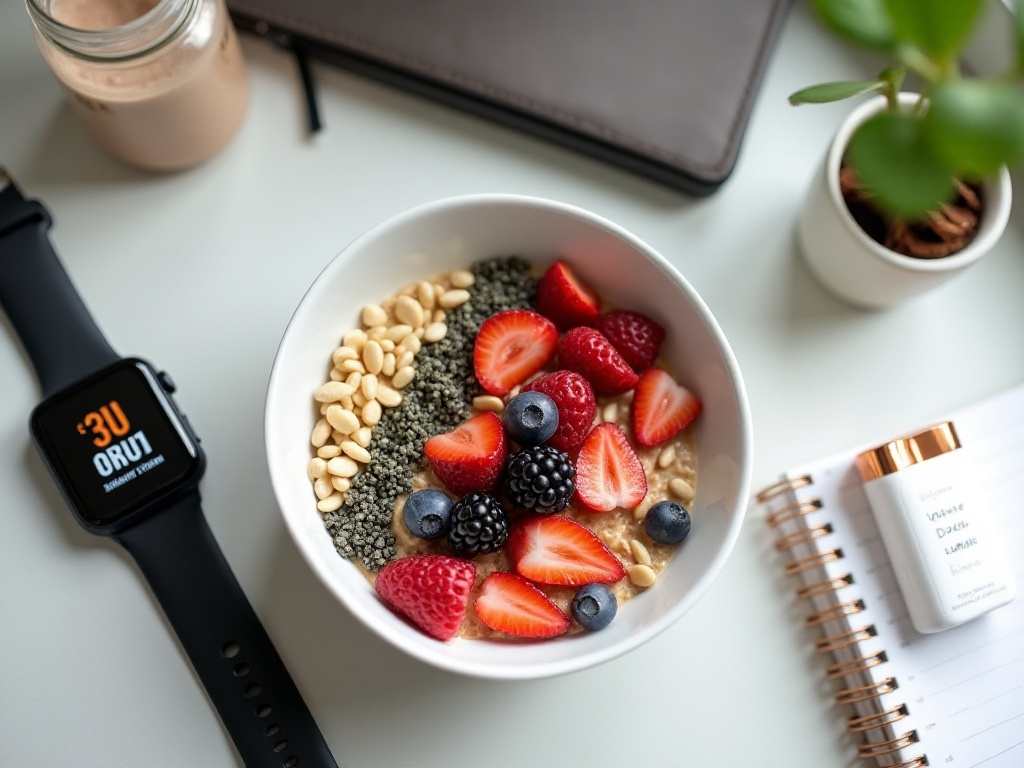
Opening Words
Do you often feel that "healthy eating" is a distant concept? Do you find nutritionists' advice too idealistic and impractical for daily life? As a former "junk food enthusiast," I completely understand this feeling. I used to scoff at healthy eating, enjoying my days with soda and chips, thinking healthy eating meant eating grass and self-punishment. Until one day, when my irregular eating habits led to stomach problems, I finally realized the importance of healthy eating.
Through years of exploration and practice, I discovered that healthy eating isn't actually that difficult; the key is finding what works for you. The important thing isn't completely giving up foods you like, but learning to balance and make wiser choices. Today, let me share with you, in the most down-to-earth way, how to make healthy eating a natural and effortless lifestyle.
The Staple Food Revolution
Remember when mom always said "eat more white rice"? Well, now we're starting a staple food revolution. Why? Because choosing the right staple foods means winning from the start. Our choice of staple foods directly affects our blood sugar levels, energy supply, and satiety, having profound impacts on overall health.
I used to love white rice and thought brown rice and whole wheat products were just self-torture. Until a health check showed high blood sugar, and the doctor suggested changing my staple foods, I started researching seriously. Through extensive reading and consulting nutritionists, I learned that refined carbohydrates lose many nutrients during processing, while whole grains retain complete nutrition, including dietary fiber, vitamins, minerals, and other important components.
After some experimentation, I discovered that whole grain staples can actually be delicious; the key is mastering proper cooking methods and combination techniques. For example, you can cook white and brown rice in a 7:3 ratio, which tastes much better than pure brown rice. Soaking brown rice for 2-3 hours before cooking can reduce cooking time and make it softer.
Quinoa is another worthy option, containing twice the protein of rice and rich in dietary fiber. Many people find quinoa strange at first taste, usually because they haven't mastered the right cooking method. Quinoa needs thorough rinsing before cooking to remove surface saponins and bitterness. Using vegetable stock instead of water while cooking can enhance its flavor.
Recently, I've fallen in love with whole wheat bread, not the super hard kind from supermarkets, but those with about 50% whole wheat content, balancing nutrition and palatability. The bread can be paired with peanut butter or avocado, adding nutrition while providing healthy fats and protein.
Besides these common choices, I've tried various whole grain staples like oatmeal, buckwheat noodles, and corn tortillas. Each has its unique nutritional profile and texture. Through continuous experimentation and adjustment, I've found the combinations that work best for me. For instance, I choose oatmeal with nuts and fruits for weekday breakfasts, saving whole wheat bread for weekends, ensuring both nutritional balance and variety.
The staple food revolution isn't just about changing ingredients; it's about changing our understanding of staple foods. They shouldn't just fill our stomachs but should be important sources of nutrition. Through proper combinations of different staple foods, we can obtain more comprehensive nutrition while enjoying the pleasure of good food.

Nutritional Balance
When people hear "nutritional balance," many immediately think "what a hassle." But with a few simple principles, nutritional balance becomes manageable. It doesn't mean preparing many ingredients for every meal or precisely calculating nutrient intake; it's about reasonable food combinations in daily eating.
Let's start with protein. Many young people today rely on takeout for all three meals, severely lacking protein intake. According to the Chinese Nutrition Society, adults need 1.0-1.2 grams of protein per kilogram of body weight daily. For example, if you weigh 60 kilograms, you need 60-72 grams of protein daily. This might sound like a lot, but a boiled egg contains 6-7 grams of protein, and a regular chicken breast contains about 27 grams.
Protein sources can be diverse, not just meat. Soy products, eggs, and fish are excellent choices. For example, 100 grams of tofu contains 8 grams of protein and is low in fat, perfect for those watching their weight. Fish not only provides quality protein but is also rich in omega-3 fatty acids, beneficial for cardiovascular health. I ensure each meal includes quality protein, like a boiled egg for breakfast, fish or lean meat for lunch, and soy products for dinner.
Fruit and vegetable intake is also crucial. Many know the "five portions of fruits and vegetables daily" rule, but what's a "portion"? Here's a simple reference: one apple counts as a portion, one banana counts as a portion, one bowl of lettuce salad counts as a portion. Fruits and vegetables provide vitamins, minerals, and numerous phytochemicals, important for preventing chronic diseases.
When choosing fruits, variety is important. Different colored fruits contain different nutrients - orange fruits are rich in carotene, purple fruits contain anthocyanins, green fruits might contain folic acid. I usually keep 3-4 different fruits at home, rotating them daily for variety and diverse nutrition.
Vegetable selection should also be diverse, with darker vegetables typically being more nutritious. Spinach, broccoli, and carrots are all nutrient-dense vegetables. Many people dislike vegetables, often due to improper cooking methods. With the right cooking techniques, vegetables can be delicious. For example, broccoli can be blanched then quickly stir-fried with olive oil and garlic; spinach can be made into salads with nuts and fruits for better taste.
Fat choice is also crucial. Healthy fats are important for the body, but choosing the right type matters. Olive oil, nuts, and avocados are good sources of healthy fats. I use olive oil for cooking, eat a small handful of nuts as snacks, and sometimes spread avocado on whole wheat bread for breakfast. These healthy fats not only make food tastier but help the body absorb fat-soluble vitamins.
Dietary Misconceptions

The Dieting Trap
When thinking about healthy eating, many people's first thought is dieting for weight loss. This mindset is problematic. I used to think this way, but the more I dieted, the worse the rebound effect. Current research shows healthy weight loss should be 0.5-1 kilogram per week; rapid dieting not only leads to rebounds but affects health.
The biggest problem with dieting is that it lowers basal metabolic rate. When we drastically reduce calorie intake, the body enters "starvation mode," reducing energy expenditure. This is why many people stop losing weight during later stages of dieting. Worse, when returning to normal eating, the lowered metabolic rate makes it easy to gain weight even with moderate eating.
The correct approach is moderate calorie control while maintaining nutritional balance. This can be achieved by reducing refined carbohydrates while increasing protein and fiber proportions. This maintains normal metabolism while providing good satiety.

Nutritional Myths
"Sugar-free drinks are healthy," "vitamin pills can replace fruits" - these are common nutritional myths. Statistics show over 60% of young people believe sugar-free drinks can be consumed freely, but artificial sweeteners may affect gut flora, and long-term heavy consumption isn't healthy.
Regarding vitamin supplements, many believe they can replace fruits and vegetables. This is incorrect. Fruits and vegetables contain not just vitamins, but fiber, minerals, and various phytochemicals that supplements can't fully replace.
Another common misconception is "eating whole grains equals healthy eating." While whole grains contain more fiber and nutrients, more isn't always better. Excessive whole grain consumption may affect mineral absorption, and sudden high intake can cause digestive issues for those unaccustomed to them.
Practical Advice

Shopping Tips
Healthy eating starts with good planning during shopping. I now shop once weekly and always make a shopping list first. Research shows people with shopping lists reduce impulse buying by 45% and are more likely to maintain healthy eating habits.
Pay attention to food freshness and seasonality when shopping. Seasonal ingredients are not only more reasonably priced but also more nutritious. For example, greens in spring, tomatoes in summer, pumpkin in autumn, and white radish in winter. When buying packaged foods, develop the habit of reading nutrition labels, particularly noting sodium content, added sugars, and trans fats.
Food storage is also important. Different ingredients have different storage requirements; proper storage maximizes nutritional value. For example, leafy greens should be stored in preservation bags in the refrigerator's vegetable compartment; fruit storage depends on ripeness; meat should be frozen in small portions for convenient thawing.
Cooking Methods
Did you know that the same chicken breast can differ in calories by up to double depending on cooking method? For 100 grams of chicken breast, boiled contains about 120 calories, while fried can reach 240 calories. I recommend trying steaming, boiling, and braising methods.
Cooking tips are important too. For example, briefly boiling ingredients before stir-frying reduces oil usage; adding salt near the end when making soup reduces salt usage; controlling cooking time for vegetables preserves nutrients.
Seasoning is an art. Besides salt and oil, we can use spices, vinegar, and lemon juice for flavor. These seasonings not only make food tastier but some offer additional health benefits. For example, ginger warms the stomach, garlic has antibacterial properties, and vinegar aids digestion.

Final Words
Healthy eating isn't a short-term battle but a continuous adjustment process. You don't need to be perfect from the start; begin with small changes. Maybe adding a boiled egg to breakfast or an extra serving of vegetables at lunch - these small changes accumulate to create unexpected effects.
Changing eating habits takes time and patience, but when you feel more energetic and happier, you'll find it's all worth it. The essence of healthy eating is self-care, not self-punishment. Let's support and encourage each other on this health journey to create better lives.
Remember, the ultimate goal of healthy eating isn't to restrict your life but to help you live better. It should be a sustainable lifestyle, not a burden. Through reasonable planning and gradual changes, everyone can find their own healthy eating style. If you're also working to improve your diet, feel free to share your experiences and concerns in the comments section, and let's support and encourage each other on this health journey.
Next
Practical Life Tips: From Theory to Practice, Making Your Life Easier and More Comfortable
A comprehensive guide exploring life hacks for productivity and efficient home management, combined with detailed insights into Chinese traditional festivals, focusing on Spring Festival customs, New Year's Eve preparations, and family reunion traditions
I Spent a Month Researching Life Hacks and Compiled This Guide to Dramatically Improve Quality of Life
A comprehensive guide covering practical life hacks and Chinese traditional festival customs, including home organization, kitchen management, cleaning tips, and cultural insights into Spring Festival, Lantern Festival, and Winter Solstice celebrations
21 Days to Transform Your Eating Habits: Making Healthy Living Less Burdensome
A comprehensive guide covering balanced nutrition, dietary control, exercise recommendations, and essential healthcare practices to help readers establish a scientific and healthy lifestyle
Next

Practical Life Tips: From Theory to Practice, Making Your Life Easier and More Comfortable
A comprehensive guide exploring life hacks for productivity and efficient home management, combined with detailed insights into Chinese traditional festivals, focusing on Spring Festival customs, New Year's Eve preparations, and family reunion traditions

I Spent a Month Researching Life Hacks and Compiled This Guide to Dramatically Improve Quality of Life
A comprehensive guide covering practical life hacks and Chinese traditional festival customs, including home organization, kitchen management, cleaning tips, and cultural insights into Spring Festival, Lantern Festival, and Winter Solstice celebrations

21 Days to Transform Your Eating Habits: Making Healthy Living Less Burdensome
A comprehensive guide covering balanced nutrition, dietary control, exercise recommendations, and essential healthcare practices to help readers establish a scientific and healthy lifestyle

